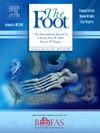拇外翻腓骨长肌结节的位置、方向和形态-负重CT评估
Q2 Health Professions
引用次数: 0
摘要
背景足外翻(HV)可能与腓骨长肌功能障碍有关,但对这些病症之间联系的研究却很少。腓骨长肌结节(PLT)可作为腓骨长肌功能的替代标记。我们的目的是比较有 HV 和没有 HV 的足部的腓骨长肌结节的位置、方向和形态。两组患者的年龄相匹配。我们比较了各组间最近报告的 PLT 测量值的差异:小结节到地面的距离(T-F 距离)、PLT 的分叉角、小结节到跖骨的角度(T-MT 角度)以及 PLT 的横截面积和圆度。HV 组的分叉角度较低(垂直度较低)(p = 0.017)。HV 组的 T-MT 角更低(p = 0.041)。结论我们发现 HV 患者的 PLT 方向存在差异(小结节的垂直度较低)。这可能表明腓骨长肌的牵拉方向与 HV 之间存在关系。PLT的大小没有差异,这表明腓骨长肌的力量在腓骨肌萎缩症的发病中可能不起作用。我们需要在这项初步研究的基础上开展进一步研究,以确定所观察到的差异与 HV 发病机制之间的联系。本文章由计算机程序翻译,如有差异,请以英文原文为准。
The position, orientation and morphology of the peroneus longus tubercle in hallux valgus – A weight-bearing CT assessment
Background
Hallux valgus (HV) may be associated with a dysfunctional peroneus longus, however there is very little research into the link between these pathologies. The peroneus longus tubercle (PLT) may serve as a surrogate marker for peroneus longus function. Our objective was to compare the position, orientation and morphology of the PLT in feet with and without HV.
Methods
In this single center series, we analyzed weight-bearing CT scans of 20 feet (12 patients) with HV and 20 feet (12 patients) without HV. Groups were age matched. We compared differences between groups for recently reported measurements assessing the PLT: tubercle-to-floor distance (T-F distance), bisecting angle of the PLT, tubercle-to-metatarsals angle (T-MT angle), and cross-sectional areas and roundness of the PLT.
Results
The T-F distance was significantly lower in the HV group (p = 0.001). The bisecting angle was lower (less vertical) in the HV group (p = 0.017). T-MT angle was lower in the HV group (p = 0.041). There was no difference in the cross-sectional area or roundness of the PLT between groups.
Conclusion
We found patients with HV had differences in orientation of the PLT (with a less vertical tubercle). This could indicate a relationship between direction of pull of the peroneus longus and HV. There were no differences in size of the PLT suggesting strength of the peroneus longus may not play a role in developing HV. Further research is needed to build upon this preliminary work and determine the link between the observed differences and the pathogenesis of HV.
求助全文
通过发布文献求助,成功后即可免费获取论文全文。
去求助
来源期刊

Foot
Health Professions-Podiatry
CiteScore
2.00
自引率
0.00%
发文量
37
期刊介绍:
The Foot is an international peer-reviewed journal covering all aspects of scientific approaches and medical and surgical treatment of the foot. The Foot aims to provide a multidisciplinary platform for all specialties involved in treating disorders of the foot. At present it is the only journal which provides this inter-disciplinary opportunity. Primary research papers cover a wide range of disorders of the foot and their treatment, including diabetes, vascular disease, neurological, dermatological and infectious conditions, sports injuries, biomechanics, bioengineering, orthoses and prostheses.
 求助内容:
求助内容: 应助结果提醒方式:
应助结果提醒方式:


